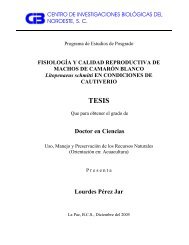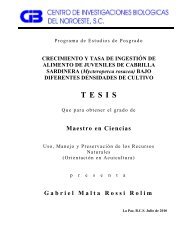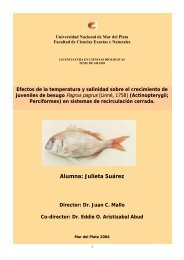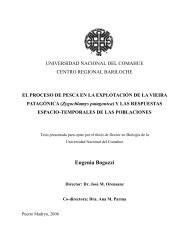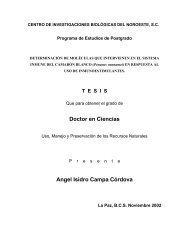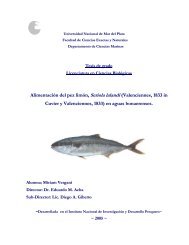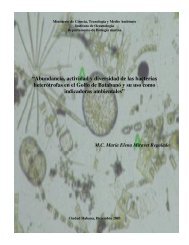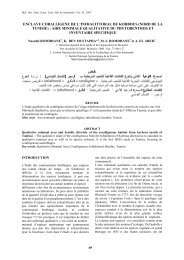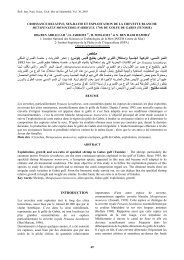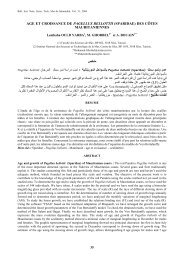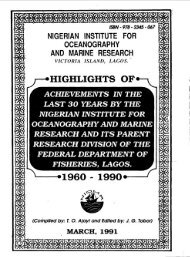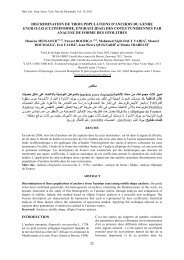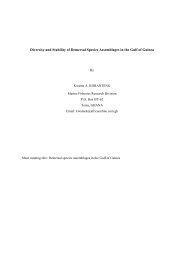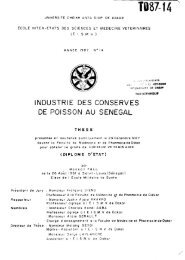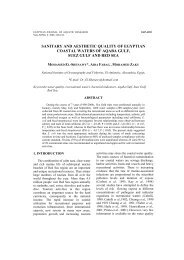Coastal vulnerability, resilience and adaptation to ... - OceanDocs
Coastal vulnerability, resilience and adaptation to ... - OceanDocs
Coastal vulnerability, resilience and adaptation to ... - OceanDocs
Create successful ePaper yourself
Turn your PDF publications into a flip-book with our unique Google optimized e-Paper software.
level of 112.9 million metric <strong>to</strong>ns, 75% of which were marine l<strong>and</strong>ings, 6.3% marine aquaculture,<br />
6.4% inl<strong>and</strong> catch <strong>and</strong> 12.2% inl<strong>and</strong> aquaculture. Of <strong>to</strong>tal global fish production, 81.9<br />
million <strong>to</strong>nnes were used for human consumption; the remainder was reduced <strong>to</strong> fishmeal <strong>and</strong><br />
oil (Grainger, 1997).<br />
Three decades ago, Gull<strong>and</strong> (1971) estimated that the maximum sustainable yield for<br />
traditionally exploited marine species would be about 100 million <strong>to</strong>nnes per year. Despite<br />
fisheries also turning <strong>to</strong> non-traditional species, marine capture has been fairly stable between<br />
78 <strong>and</strong> 86 million <strong>to</strong>nnes since 1986 (although an upward trend can be seen as of 1994),<br />
whilst marine aquaculture has increased from 3 <strong>to</strong> more than 7 million <strong>to</strong>nnes over the same<br />
period (Grainger, 1997). Caught but not included in the statistics are species of low commercial<br />
value <strong>and</strong> juvenile species. This unwanted bycatch has been estimated at between 18 <strong>and</strong><br />
39 million <strong>to</strong>nnes per year (Alverson et al., 1994).<br />
An important sign that marine fish are currently being overexploited is the increasing<br />
catch of mature <strong>and</strong> senescent fish <strong>and</strong> the decreasing catch of undeveloped <strong>and</strong> developing<br />
fish. This suggests that fewer fish are being born than are caught (Grainger <strong>and</strong> Garcia, 1996).<br />
This trend reflects the intensification of fisheries since 1950 <strong>and</strong> the increase in the proportion<br />
of marine fish subject <strong>to</strong> declines in productivity. It also underlines the fact that the<br />
growing <strong>to</strong>tal <strong>to</strong>nnage of fish production over this period gives a misleading picture of the<br />
state of world fisheries <strong>and</strong> a false sense of security (Grainger <strong>and</strong> Garcia, 1996). However,<br />
projections by individual nations, especially China, suggest that marine fish l<strong>and</strong>ings will continue<br />
<strong>to</strong> increase significantly. Continued overexploitation <strong>and</strong> declining productivity could<br />
result in dem<strong>and</strong>s for marine fish exceeding annual production, with the consequent effect of<br />
increased prices <strong>and</strong> reduced availability of marine protein <strong>to</strong> many people in developing<br />
countries.<br />
In addition <strong>to</strong> overexploitation, part of the explanation for the stress on marine fish<br />
s<strong>to</strong>cks lies in the loss of coastal fisheries habitats as a result of marine pollution <strong>and</strong> their<br />
conversion <strong>to</strong> aquaculture or other productive l<strong>and</strong>. These habitats form the breeding, nursery<br />
<strong>and</strong> feeding grounds for many fish <strong>and</strong> crustaceans that are currently exploited. In countries<br />
such as Thail<strong>and</strong> <strong>and</strong> the Philippines, it is estimated that more than 70% of the mangrove<br />
area has been cleared <strong>and</strong> replaced by shrimp ponds (WRI, 1996). The socio-economic impacts<br />
of coastal aquaculture developments that require major alteration of coastal ecosystems can<br />
be far-reaching.<br />
Apart from the direct loss of mangrove <strong>and</strong> other valuable coastal systems, coastal aquaculture<br />
can have a number of other adverse consequences on coastal systems. Reported impacts<br />
include l<strong>and</strong> subsidence, acidification of soils <strong>and</strong> estuarine waters, salinisation of<br />
groundwater <strong>and</strong> agricultural l<strong>and</strong>s <strong>and</strong> the subsequent loss of economic <strong>and</strong> environmental<br />
goods <strong>and</strong> services upon which coastal communities rely (WRI, 1996). <strong>Coastal</strong> aquaculture has<br />
led <strong>to</strong> drops in agricultural productivity <strong>and</strong> farm incomes, reduced water supplies, loss of income<br />
from fishing <strong>and</strong> forestry <strong>and</strong> increasing hazard of coastal flooding. One of the more recent<br />
socio-economic problems resulting from large-scale aquaculture development is the<br />
growing frequency of disease outbreaks, including algae blooms known as red tides, which can<br />
cause mass fish kills, resulting in major losses of income <strong>and</strong> threats <strong>to</strong> public health (WRI,<br />
1996).<br />
2.3.3. Nature conservation<br />
As discussed in Section 2.1, coastal zones provide a range of environmental goods <strong>and</strong> services<br />
that are essential <strong>to</strong> human social <strong>and</strong> economic well-being. Although each ecosystem function<br />
provides different goods <strong>and</strong> services, its performance is often strongly connected <strong>to</strong> that<br />
of other functions. Development in coastal zones is traditionally triggered by the many economic<br />
opportunities provided by the user <strong>and</strong> production functions. However, often there has<br />
been little awareness that regulation functions provide the essential conditions for the full<br />
performance of these user <strong>and</strong> production functions. It is often not recognised that there are<br />
limits <strong>to</strong> the extent <strong>to</strong> which natural coastal systems allow for the exploitation of resources<br />
produced in coastal zones or that radical changes <strong>to</strong> these systems may adversely affect the<br />
availability or regeneration of these resources.<br />
One of the main reasons for the ongoing loss of natural habitat due <strong>to</strong> human activities is<br />
the fact that the importance of nature <strong>and</strong> a healthy environment <strong>to</strong> human well-being is not<br />
fully reflected in economic planning <strong>and</strong> decision-making. It is difficult <strong>to</strong> attach a monetary<br />
7



